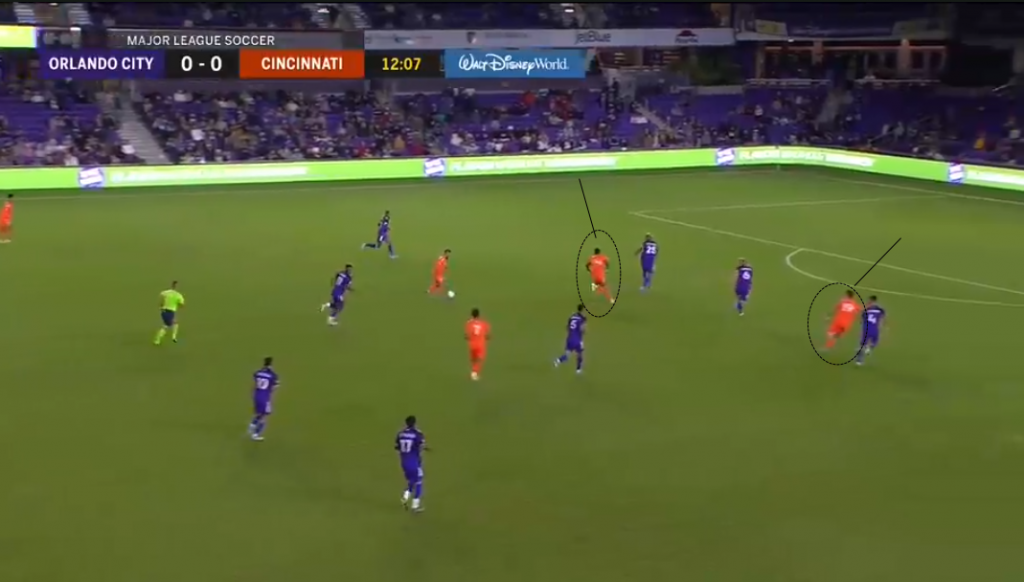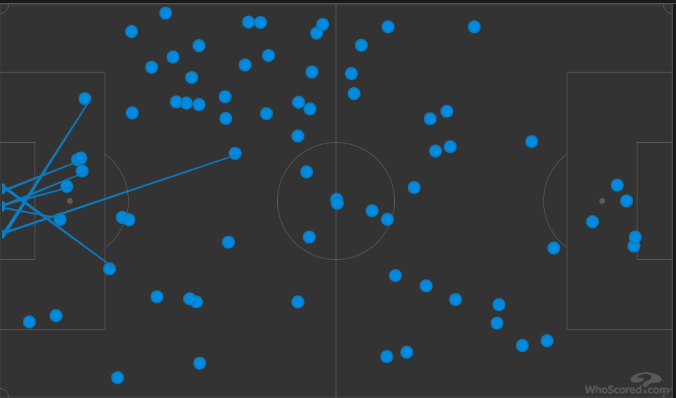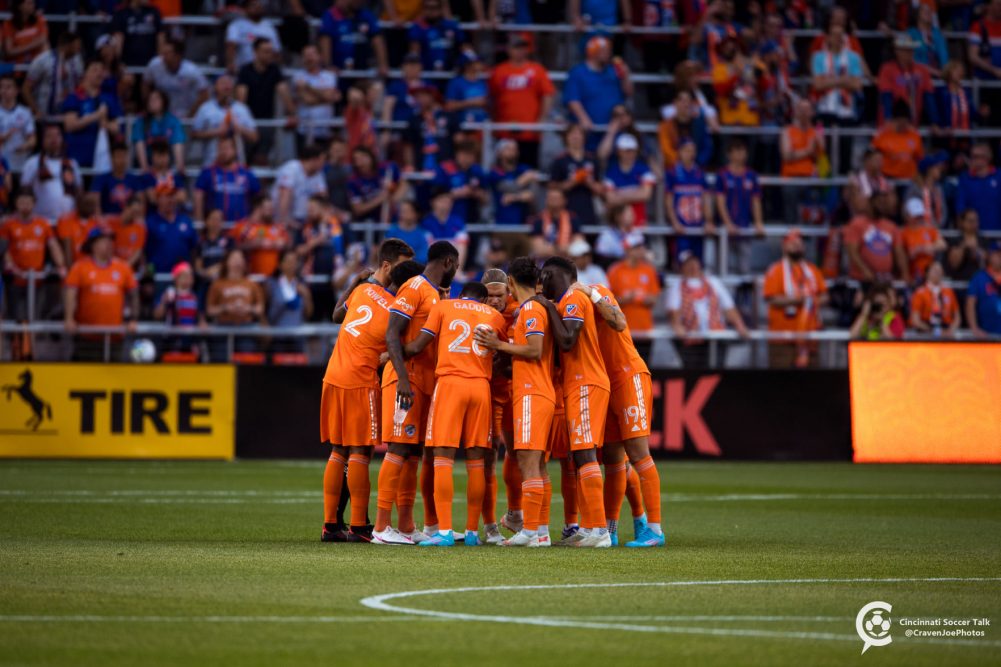Three points. Finally. FC Cincinnati’s 2-1 win over Orlando City SC on Saturday wasn’t always pretty but supporters of the Orange and Blue surely won’t complain.
The topline stats for Saturday’s game, except the scoreline, of course, are pretty ugly. Orlando enjoyed 69% possession and took 18 shots, double FCC’s total. Orlando ended the night with 45 touches in FCC’s penalty area compared to just 15 for Cincinnati. That’s not a recipe for success in most circumstances. However, there’s more to FCC’s performance than is evident at a first glance. Overall, Orlando generated better chances over the course of the game but not by as much as the possession and shot stats might indicate, at least according to expected goals.
Clearly, Orlando controlled large portions of the match, dominating possession in FCC’s half. However, Cincy’s defense kept Orlando’s attack largely in check and FCC found space, and, more importantly, success on the counterattack. It wasn’t a blueprint for how Pat Noonan will hope to win games going forward but the Orange and Blue did enough to keep the game in reach and get out of Florida with its first win of the season.
After Serious Pressure An Effective Adjustment
In the first half, the Orange and Blue lined up in the same 5-3-2 as last week’s draw against DC United. Ray Gaddis picked up a knock sometime during the week so rookie Ian Murphy got the call to make his first MLS start at left wingback. Orlando took advantage of the rookie’s side, looking to overload the right as well as Orlando’s attackers testing Murphy’s one-on-one defending ability. In the 42nd minute, Murphy was caught flat-footed as Junior Urso ran past him to head in the Lions’ equalizer.
At halftime, Pat Noonan adjusted. Isaac Atanga came on for Murphy and left center back Tyler Blackett shifted over to play left back, leaving FCC in a back four defensively. The second half was far more solid. Despite Orlando’s huge advantage on the ball, FCC limited the Lions to half-chances at best, 0.50 xG on 10 shots as opposed to the 0.92 xG on eight shots in the first half.

Despite enjoying lots of possession in the final third, FCC largely kept Orlando away from areas directly in front of the penalty area where Orlando’s playmakers could open up FCC’s defensive line. FCC’s defenders gave up space out wide but a more compact defensive shape led to 16 clearances as Orlando tried to break through from wide. Whereas FCC relied heavily on Alec Kann’s shot stopping prowess in the first half, he only made one save in the second half.
Speaking of Kann’s contributions…
Alec Kann’s Shot Stopping On Display
When Alec Kann joined FC Cincinnati in free agency, I wrote about how much of an upgrade he could be over FCC’s previous goalkeepers in terms of shot stopping. There’s still a long way before we can judge my previous arguments but Saturday night was an example of how a good shot stopper in goal can keep their team in the game and get a result.
According to Football Reference (which has slightly different xG numbers than MLS Soccer because they utilize different models), Orlando generated 1.7 xG on Saturday night. However, Fbref also has a statistic to help understand, among other things, goalkeeper performance: Post-Shot Expected Goals. Basically, PSxG looks at shots on target and accounts for where the shot was located on the frame, how hard it was hit, as well as other factors. Here’s a great explainer if you have the time and/or interest. I also did my best here in a more FCC-specific context.
Against Orlando, Alec Kann faced shots worth 2.2 PSxG. One goal was scored. So Kann’s shot-stopping is credited with saving shots worth well over a goal. In the first half, there were multiple high-quality chances that Kann kept out including this chance from Ercan Kara in the first half.
WHAT a save by Alec Kann to keep #FCCincy ahead in the 22'#ORLvCIN | #AllForCincy pic.twitter.com/5UEyCluXC3
— FC Cincinnati (@fccincinnati) March 13, 2022
Simply put, there aren’t many keepers in MLS who make the reaction save Kann did on Kara’s diving header. Relying on your goalkeeper to stand on his head to keep you in games isn’t a reliable, long-term strategy for success. But when you have a keeper who just might be a very good shot stopper, games like Saturday will happen from time to time. It’s still too early to draw sweeping conclusions but Saturday reinforces my hopes that FCC might not just have an average shot stopper in goal, but maybe even a very good one.
Playing On The Counter
Despite sitting deep in its defensive half for much of the game, FCC was still dangerous on the counter-attack throughout the 90 minutes. There were certainly some clearances where FCC players just looked to clear their lines but FCC’s attacking players had a clear idea of where to find space on the counter.
FCC’s first goal came in semi-transition after Alvas Powell found Lucho Acosta in space in the final third. Both Dom Badji and Brandon Vazquez were in advanced positions and Badji made an excellent run across the faces of Orlando’s center backs, drawing their attention and getting both to turn their hips towards his side. (Watch Coach Gough’s video about Badji’s movement if you haven’t already).

Vazquez was already on the goal side of left back João Moutinho, and since Robin Jansson had already committed to tracking Badji, Lucho Acosta had a relatively simple pass to find the striker, who coolly slotted the ball past Orlando’s goalkeeper. Badji and Vazquez’s partnership has been impressive so far. Even in games like Saturday’s where FCC can’t do much in possession, getting the ball to Lucho Acosta in space and allowing him and FCC’s other attackers to run at retreating defenders can be an effective offensive strategy.
FCC’s strikers took advantage of Orlando’s flanks on the break, finding space behind Orlando fullbacks João Moutinho and Ruan, who consistently pushed forward to provide width in the attack.

The right side in the attack was clearly an emphasis in the game plan and FCC put Orlando under pressure throughout the night. Though some counters didn’t end in shots, the ideas were the right ones. With more time together and familiarity, we should expect FCC to be even more dangerous on the break.
Even in matches where the Orange and Blue are under significant pressure, this iteration of FCC is much better set up to take points previous teams would not. With a keeper who can stop shots, a coaching team that will make adjustments to improve things, and attackers who are dangerous on the counter-attack, the Orange and Blue might not play the prettiest style but it should mean more points.













